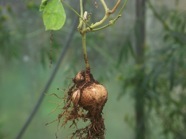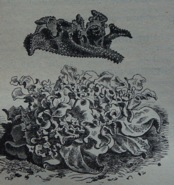
I-J
ICE PLANT
And the name says it all, the leaves of the plants looks as if they have been sprinkeled with little ice crystals. Ice plants (mesembryanthemum crystallinum) are very low staying plants, very easy to grow from seed (sow in April, keep frost-free) and you get nice tasting edible leaves and wonderful flowers as well. They do prefer a nice sunny spot (otherwise they will refuse to flower). The leaves are the edible part, having a refreshing sweetish taste, a wonderful addition to salads.
JALTOMATO
Jaltomatos (Jaltomato procumbens) are unrelated and don’t even resemble tomatoes. They are plants who produce round black berries of just about 2 cms big, who contain a lot of seeds and are edible, but best made into jams or other things. Plants are very easy to grow, resow abundantly over here, and in mild winters their roots survive and they resprout from these.

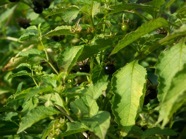
JELLY MELON
Jelly melon is a very distant relative of cucumber and melon. the fruits are green in an unripe state and orange when they are ripe. They are produced abundantly when they have the necessary heat. The fruits contain a peculiar looking, jelly-like bright-green pulp, which can be eaten. Here we definitely have something that’s controversial: some like it, saying it tastes like bananas and lemon, others (me included) say it tastes like a bland lemon, still others have other opinions...
Still I always place a few plants, just because the fruits look so wonderful, even quite ferocious....They especially want lots of warmth, and aren’t really fussy for anything else, one plant gives you plenty of ‘kiwano’ fruit (cucumis metuliferus), as we call them. In the exceptional 2003 summer I got 106 fruits from one plant, grown outside! On the other hand, the bad summer of 2008 gave me nothing, not a single fruit...
JERUSALEM ARTICHOKE
Being closely related to the sunflower everybody knows, this becomes quite big as well, some varieties reach up to 3 metres or more....And once you have them, you won’t get rid of them, unless you weed them excessively or have lots of mice who eat them . Jerusalem artichokes (helianthus tuberosus) are one the most frost-hardy vegetables you can grow, -30° is no problem for them, the tubers will survive. Don’t let the tubers dry out during wintertime, they don’t stand being dried out.
Growing is easy, just obtain some tubers (from a friend, or organic shops sell them,or...) plant them in March-April or even before the winter and they will grow (give them the necessary space!). You will be rewarded with lots of flowers in autumn and a whole lot of fresh tubers, which can be used in different ways for warm dishes.
A particularity of the tubers is the extraction of inuline, which is used for people with diabetes.
Lots of variaties, red, white, brownish, knobbly,....

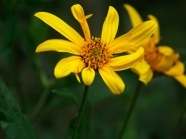
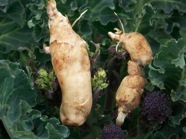
JICAMA
There’s a bit of confusion here, the name jicama seems to be used for two species: pacchyrhizus erosus and pachyrhizus tuberosus. However, there’s a difference between these two species, first the erosus:
the plants stay low, barely 40-50 cms, and grow slowly but steadily throughout the season, even producing the edible root during late summer over here. In a warm year, erosus can even be grown outside over here, but don’t expect big roots, these roots do have a very nice sweet taste (after being peeled) and are preferably eaten raw. I haven’t seen any forming of flowers on these.
Second: tuberosus: these are completely different, and they need a very long, frost-free climate to produce anything. I never could harvest the tiniest bit of root to try, yet I’ve seen pictures of really big edible roots, over 5 kgs! But these were grown in Portugal or California/Florida, frost-free indeed. The plants grow big, 4 or 5 metres is the biggest I experienced over here (in the greenhouse, it overtook half of the place), I never saw a flower on these either. The roots seem to be as tasty as the erosus roots, but, as I told before,I have yet to find out..


